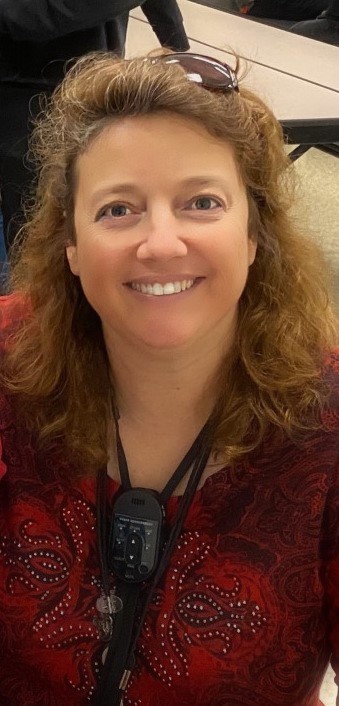

Storytelling With Comics |
Explore and create : Creation lab
Danielle Abernethy Debbie Bohanan
Learn how students can use the visual clues of comic scenery, coloring and text-bubble shapes to infer emotions and contexts. Storytelling with visual cues helps students explore creative communication while meeting standards. Bernajean Porter and Disney's storytelling process, along with the Marvel Method, will be explored in the process.
| Audience: | Coaches, Library media specialists, Teachers |
| Skill level: | Beginner |
| Attendee devices: | Devices required |
| Attendee device specification: | Smartphone: Android, iOS, Windows Laptop: Chromebook, Mac, PC Tablet: Android, iOS, Windows |
| Participant accounts, software and other materials: | The tool is not the focus of this session - but we will be building. We will share a sample of each of the following and then you can choose during the hands on time which tool fits your creativity needs: Google Slides Bitmoji Storyboard That Make Belief Comix Wixie And - please feel free to bring another tool of your choice since the tool is not the focus! Just know these are the ones that the presenters are familiar with. |
| Topic: | Creativity & curation tools |
| Grade level: | PK-12 |
| Subject area: | Language arts, Social studies |
| ISTE Standards: | For Students: Creative Communicator
|
| Disclosure: | The submitter of this session has been supported by a company whose product is being included in the session |
| Influencer Disclosure: | This session includes a presenter that indicated a “material connection” to a brand that includes a personal, family or employment relationship, or a financial relationship. See individual speaker menu for disclosure information. |
Students in our Florida schools worked on comics with various tools. The tool was not the important aspect of this training, it is the actual process. Each student had the opportunity to choose the tool that best suited their needs based on availability and skill level.
They all Skyped with Danielle for an introduction of Storytelling with Comics. She introduced inference based on just the imagery of a scene, whiting out the text bubbles so the speech did not give away anything. The students dived into the meaning of color, the use of stark lines versus soft lines and how even the shape of a text bubble can help a reader infer meaning. The students then filled in the text bubbles with their own words, re-writing the comic. From there, all students learned the steps of storytelling and how to tell their story through comics, starting with storyboarding and moving through each step to publishing.
We have seen the students as early as second grade become excited about writing and reading. They are creating weekly comics for their peers on character count words, events in history, science themes and even topics of today that impact the students. The older students are media students who often think of media as only video. Working with print and digital imagery, they are learning how scenery can help convey meaning.
In the workshop, participants will follow the same introduction and go through the process of writing their first and even second comic. The first will be done using a comic (and discussing the fair use of copyright) and then the second will be done by the teachers using a program of their choice.
I. Introduction of presenters and topic (5 Minutes)
A. Presenters
B. What is storytelling? Digital Stortyelling has a process, which we'll follow as we create our own stories using comics.
C. What defines a comic? Review the elements of a good comic
D. Visual Literacy Elements
II. Storytelling Process and Elements: Diving into the process and elements, we will explore the storyboard's necessity, then the elements of a good story. We'll share a different program at each element to show why the tool is not the focus, and yet give the audience an option. (35 minutes)
A. Storyboarding
B. Character - the character journal (Google file will be shared)
C. Setting - simple settings and props
D. Text- the power of the speech bubble
E. Color - color overlays or color theming importance
F. Panel layout - how to change the layout with various tools.
III. Extra hands on time to choose the tool of their choice to create a 3 panel comic about their ISTE experience. (30 minutes)
IV. Show and Tell (10 minutes)
V. Wrap Up (5 minutes)
https://www.gse.harvard.edu/news/uk/17/12/comics-classroom
http://www.ncte.org/magazine/archives/122031
http://popcultureclassroom.org/2017/12/20/a-newbies-guide-to-teaching-comics/
https://www.commonsense.org/education/top-picks/classroom-friendly-websites-and-apps-for-making-comics
http://www.ampkids.com/blog/creating-comics-in-the-classroom

Danielle's passion for educational technology began in 1997 when all she had access to was a computer in a closet of the media center with Internet. As a former technology coach, DEN STAR, DEN Leader and member of other educational organizations, she has learned the power of networking. Danielle collaborates with Heather on various classroom activities throughout the year. She has presented at FETC, SCEDTech, GAETC, and ISTE. Danielle is also an executive member of the Digital Storytelling Network of ISTE.

Debbie Bohanan is a 30-year career educator in Osceola County. She has worked with students from K-12th grade in a variety of positions. Debbie's certifications include Elementary & Primary Education, and Technology 6-12. She is ESOL Endorsed, National Board Certified, DEN Star and leadership council member for the Discovery Educator Network, and TIE Educator (Tech4Learning Innovative Educator). Her degrees include a bachelor's degree in elementary education (Florida State University) and a master’s degree in Education Media Design and Technology (Full Sail University). Debbie is passionate about her work and always looks for creative ways to engage her students using multimedia.